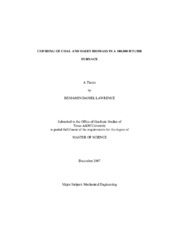| dc.description.abstract | Dairy biomass (DB) is evaluated as a possible co-firing fuel with coal. Cofiring
of DB offers a technique of utilizing dairy manure for power/steam generation, reducing
greenhouse gas concerns, and increasing financial returns to dairy operators. The effects
of cofiring coal and DB have been studied in a 30 kW (100,000 BTU/hr) burner boiler
facility. Experiments were performed with Texas Lignite coal (TXL) as a base line fuel.
The combustion efficiency from co-firing is also addressed in the present work.
Two forms of partially composted DB fuels were investigated: low ash separated
solids and high ash soil surface. Two types of coal were investigated: TXL and
Wyoming Powder River Basin coal (WYO).
Proximate and ultimate analyses were performed on coal and DB. DB fuels have
much higher nitrogen (kg/GJ) and ash content (kg/GJ) than coal. The HHV of TXL and
WYO coal as received were 14,000 and 18,000 kJ/kg, while the HHV of the LA-PC-DBSepS
and the HA-PC-DB-SoilS were 13,000 and 4,000 kJ/kg. The HHV based on
stoichiometric air were 3,000 kJ/kg for both coals and LA-PC-DB-SepS and 2,900 kJ/kg for HA-PC-DB-SoilS. The nitrogen and sulfur loading for TXL and WYO ranged from
0.15 to 0.48 kg/GJ and from 0.33 to 2.67 for the DB fuels.
TXL began pyrolysis at 640 K and the WYO at 660 K. The HA-PC-DB-SoilSs
began pyrolysis at 530 K and the LA-PC-DB-SepS at 510 K. The maximum rate of
volatile release occurred at 700 K for both coals and HA-PC-DB-SoilS and 750K for
LA-PC-DB-SepS.
The NOx emissions for equivalence ratio (φ) varying from 0.9 to 1.2 ranged from
0.34 to 0.90 kg/GJ (0.79 to 0.16 lb/mmBTU) for pure TXL. They ranged from 0.35 to
0.7 kg/GJ (0.82 to 0.16 lb/mmBTU) for a 90:10 TXL:LA-PC-DB-SepS blend and from
0.32 to 0.5 kg/GJ (0.74 to 0.12 lb/mmBTU) for a 80:20 TXL:LA-PC-DB-SepS blend
over the same range of φ. In a rich environment, DB:coal cofiring produced less NOx
and CO than pure coal. This result is probably due to the fuel bound nitrogen in DB is
mostly in the form of urea which reduces NOx to non-polluting gases such as nitrogen
(N2). | en |


